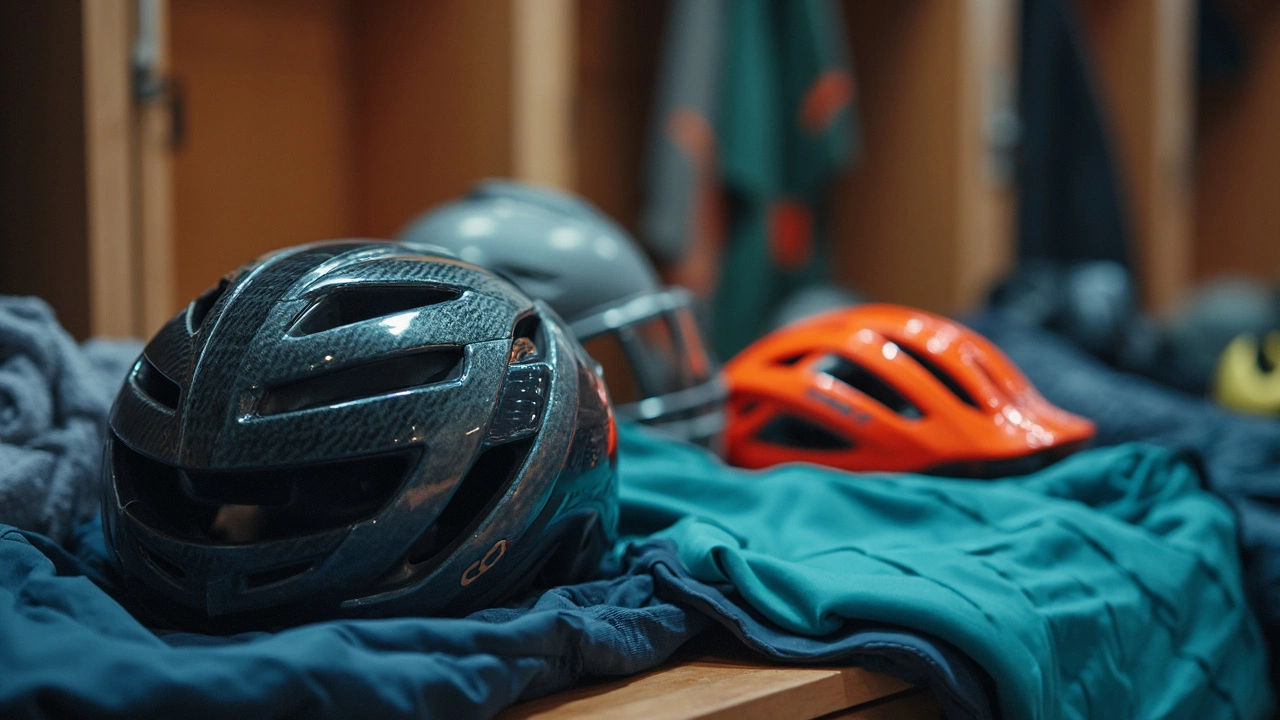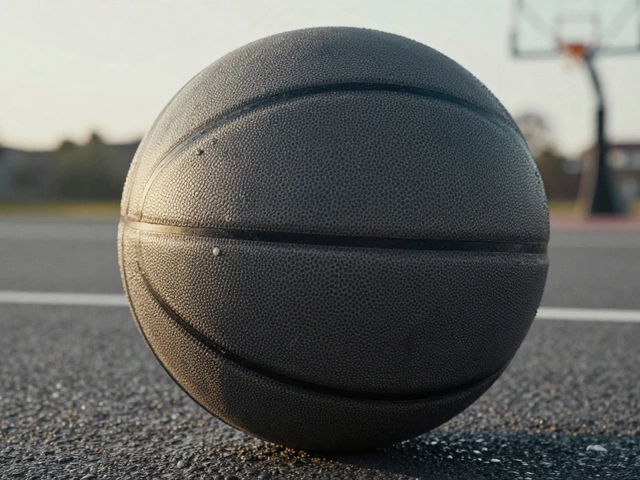If you've ever wondered why professional athletes rarely get hurt in a crash or fall, it's not just luck, it's their gear. Most sports equipment is built with specific materials for safety, comfort, and even a competitive edge. Pick the wrong helmet, and you're risking more than just a headache.
Ever tried playing soccer in a pair of street shoes or running a marathon in a heavy cotton tee? How your gear is made makes a huge difference. Advanced synthetics keep you cool and dry. Foam padding absorbs blows. Strong plastics spread out the impact so you don't break a bone. It's not just about looking cool—it's about protection and performance.
Cheap knock-offs might look the part but usually swap out high-quality materials for weaker stuff, which can mean blisters, tears, or even injuries. You can avoid a lot of pain by knowing what goes into real sports gear and why those materials are chosen. Ready to level up your gear knowledge?
- Why materials matter in sports gear
- Plastics and composites in protective gear
- Synthetics, cotton, and blends in clothing
- Rubber, foam, and cushioning in shoes
- Smart textiles and tech innovations
- Tips for choosing the right gear
Why materials matter in sports gear
Think about what would happen if you wore leather boots to run a marathon or played football in a wool sweater. The materials make or break your game. Modern sports gear is made to give you an edge, protect your body, and help you move better—sometimes all at once.
The right stuff matters for a bunch of reasons:
- Protection: Helmets, pads, and guards need to absorb shock, spread out impacts, and stay strong over time. If the materials are weak, you could get hurt.
- Comfort: Sports gear made from breathable fabrics means less sweat, fewer distractions, and more focus on the game itself.
- Performance: Lightweight and flexible gear helps you move quicker. Runners wouldn’t want chunky shoes weighing them down.
- Durability: Quality materials resist tears, withstand hits, and hold up season after season. That’s how pros avoid shopping for new gear every month.
- Regulation: Most leagues set rules about which materials are allowed. Some plastics or metal might get banned for safety reasons.
Here’s a quick look at how different materials stack up for popular gear:
| Gear Item | Main Material | Why It Matters |
|---|---|---|
| Football Helmet | Polycarbonate Plastic | Absorbs and disperses impact |
| Running Shirt | Polyester (synthetic fabric) | Wicks sweat, quick-dry |
| Basketball Shoes | Rubber, Foam, Mesh | Traction, shock absorption, breathability |
| Cycling Shorts | Spandex Blend | Flexibility, reduces chafing |
| Shin Guards | High-density Foam & Plastic | Cushioning and protection |
If you’re thinking of grabbing new gear, check what it’s made of. It’s not about brand hype—it’s about smart choices. Materials shape everything from player safety to how well you’ll play. Don’t let a cheap shortcut send you to the bench.
Plastics and Composites in Protective Gear
Peek inside a bike helmet or hockey pads and you’ll find more science than you’d guess. Most protective sports gear blends different types of plastics and composite materials to absorb shock, spread impact, and let you keep moving without a ton of bulk.
The heavy lifters here are polycarbonate, ABS plastic, and high-density polyethylene (HDPE). These are the go-to materials for helmets, face masks, and pads. Why? They’re tough as nails but light enough that you can wear them for hours. Polycarbonate, for example, is used in both pro football helmets and astronaut visors—talk about proven toughness.
Composites like carbon fiber and fiberglass step things up for high-end players. Carbon fiber is insanely strong and way lighter than old-school plastics. That’s why you’ll find it in lacrosse sticks, racing bike frames, and some custom football helmets. It actually protects better while keeping weight down—nobody likes a heavy helmet wobbling around.
Check out this comparison of common protective gear materials:
| Material | Main Uses | Key Benefits |
|---|---|---|
| Polycarbonate | Helmets, visors | High impact resistance, light, doesn’t shatter |
| ABS plastic | Helmet shells, pads | Affordable, easy to shape, solid protection |
| HDPE | Hockey gear, shin guards | Durable, weatherproof, flexible |
| Carbon fiber | Pro helmets, sticks, frames | Super light, crazy strong, cuts weight |
| Fiberglass | Some helmets, pads | Good impact spread, mid-weight, strong |
It’s not just about hard shells. Most gear combines a tough outer layer with a softer inside—like expanded polystyrene (EPS) foam—to soak up hits. Take a football helmet: hard plastic spreads the blow, while the foam cushions your head. This combo can actually lower concussion risk by around 50% compared to older gear, according to recent sports medicine reports.
If you want real protection, stick with certified gear—especially for contact sports. Look for labels like NOCSAE or CE certification. Never use a cracked helmet or one with obvious dents; once the shell is damaged, it can’t do its job.
Synthetics, Cotton, and Blends in Clothing
If you pull on a jersey, whether it's for soccer or basketball, chances are it's made from synthetic fibers like polyester or nylon. Synthetic fabrics are a mainstay for sports gear because they wick away sweat, dry quickly, and withstand tons of washes. Cotton used to be the default, but it soaks up sweat and gets heavy, which isn't ideal when you're trying to beat your best time.
Polyester is the big player here. It's light, strong, and holds its shape way longer than natural fibers. You’ll also see nylon in sportswear, especially for stuff that needs to stretch a bit, like yoga pants or running tights. Elastane, often called spandex or Lycra, gets thrown into the mix when you need major stretch—think swimsuits and compression gear. These blends help gear move with you, not against you.
If you check out those “moisture-wicking” shirts at the store, it's the polyester or nylon pulling away your sweat so you don't end up cold and soggy. Cotton, though comfy for lounging, holds on to every drop of sweat, which can actually chill your body down once you stop moving. Not a huge deal if you’re just walking your dog, but brutal in a long run or serious training.
Here’s a quick breakdown of what’s commonly used in sports clothing and why:
- Polyester: Dries fast, stays light, keeps its color even after dozens of washes.
- Nylon: Flexible, tough, adds stretch, and feels smooth on the skin.
- Elastane (Spandex/Lycra): Endless stretch, used for compression or close-fitting clothes.
- Cotton: Super comfy but not so great for heavy sweating or wet conditions.
- Blends: Mix of synthetics and cotton for comfort plus performance.
Sizing and performance aren’t the only reasons for all these fabric combos. Some stats: In 2023, over 90% of NFL and Premier League jerseys were made from 100% polyester or a polyester blend. Pure cotton gear was almost non-existent on the field. If you care about odor control, lots of brands now use special treatments with silver ions or charcoal to keep your clothes smelling fresh, even after hard workouts.
| Material | Primary Benefits | Common Uses |
|---|---|---|
| Polyester | Lightweight, wicks moisture, durable | Jerseys, shorts, base layers |
| Nylon | Flexible, smooth, abrasion-resistant | Leggings, jackets, mesh panels |
| Elastane | High stretch, keeps shape | Compression gear, swimsuits |
| Cotton | Comfort, softness, breathability | Hoodies, sweatpants, casual tees |
| Blends | Performance + comfort | Training gear, lifestyle apparel |
If you want your sports gear to last, stick with synthetics or blends for practices, games, and tough workouts. Save the cotton for rest days or hanging out. And always check the tag before buying—fabric matters more than you think.

Rubber, Foam, and Cushioning in Shoes
If you've ever wondered why some shoes feel amazing while others leave your feet aching, it comes down to what’s under the hood. The guts of almost any sports shoe are built around three things: rubber outsoles, foam midsoles, and all sorts of cushioning systems. Brands sink millions into designing these layers because they make a huge difference when you're running, jumping, or pivoting.
Take rubber. Most sports shoes use rubber for the outsole because it grips different surfaces without wearing down too fast. Some shoes use a soft, sticky rubber for indoor courts to prevent slips, while trail running shoes stick with harder rubber for better durability against rocks and rough ground.
Foam is the real MVP for comfort. Midsoles are usually made from EVA (ethylene vinyl acetate) or PU (polyurethane) foam. EVA is lightweight and squishy, so it feels plush on runs or workouts. PU is denser and bounces back more, which works better for sports with lots of jumping like basketball. Ever heard of Nike’s Air or Adidas’s Boost? Both are creative spins on foam cushioning to make your steps comfy and springy.
Shoe companies are obsessed with the science here because cushioning isn’t just about comfort—it actually helps protect your joints. When your heel hits the ground during a run, the impact can be as much as three times your body weight. Good cushioning absorbs some of that shock, helping reduce the risk of injuries like shin splints and stress fractures.
Here’s a quick comparison of some popular midsoles and what they’re best at:
| Material | Feel | Durability | Sports Best For |
|---|---|---|---|
| EVA Foam | Softer, lighter | Moderate | Running, cross-training |
| PU Foam | Denser, supportive | High | Basketball, court sports |
| Rubber Outsole | Grippy | High | Trail running, tennis |
A few tips before grabbing your next pair of shoes:
- Look for sports gear brands that clearly explain the cushioning used in their shoes. If they’re vague, that’s a red flag.
- Try shoes on in the afternoon. Your feet swell during the day, and you want a fit that works when you’re active.
- Don’t get hung up on hype. Cushioned “super shoes” aren’t for everyone—if your feet ache after a few wears, switch it up.
- If you play multiple sports, consider separate shoes for each—designs, foam density, and outsole grip can be totally different depending on the movement and surface.
The right blend of rubber and foam can turn your average workout into something easier and safer on your joints—so pay attention to what’s under your feet.
Smart textiles and tech innovations
Sports gear isn't just about old-school fabrics anymore. Thanks to smart textiles and tech innovations, what you wear can actually track your stats, change how it feels based on the weather, and even help you avoid injuries. We're talking gear that's smarter than most smartphones were a decade ago.
Take smart shirts for example. Some can measure your heart rate, breathing, and even how fast you're moving. Brands like Under Armour and Hexoskin have built sensors into the fabric that sync with your phone so you can check your performance in real time. No more guessing if you’re pushing hard enough—your shirt knows.
There's also clothing that adjusts to your sweat level and temperature. Nike’s AeroAdapt fabric has tiny vents that open up when you sweat, keeping you cool during those intense moments. Athletes in the NBA and Premier League have worn smart vests embedded with GPS and motion trackers. Coaches use the data to design better workouts and keep players safe from overtraining.
| Tech | How It Works | Main Benefit |
|---|---|---|
| Smart Sensors | Built into shirts, socks, knee pads | Monitors activity & health stats |
| Adaptive Fabrics | React to sweat, temp, movement | Optimizes comfort and dryness |
| GPS Tracking | Embedded vests and patches | Provides detailed movement analytics |
| Impact Detection | Microchips in helmets or pads | Records hits to prevent injury |
Why does all this matter? For one, real-time info lets athletes tweak their training on the fly. If a footballer’s GPS vest shows they’ve run too many sprints, coaches can step in before an injury happens. Impact-sensing mouthguards in rugby now record how hard a tackle is and signal if a player may need concussion checks.
If you're thinking this sounds expensive, you're right—to a point. But even regular sports gear brands are adding simpler tech, like moisture-wicking thread that works almost as well as high-end smartwear. Before you buy, check if your gear offers any of these tech tweaks. Even a basic feature can make your sports gear work harder for you—and maybe keep you off the injury list.
Tips for choosing the right gear
Picking the right sports gear isn’t just about what looks good on you. The materials, fit, and features make a massive difference, especially if you want safe, long-lasting equipment. Let’s break down what to watch for so you don’t waste money or risk getting hurt.
- Sports gear materials matter. Real helmets and pads are made from impact-resistant plastics and foams. If you see anything flimsy, skip it—cheap stuff won’t protect you properly.
- Check for moisture-wicking labels on clothing. Polyester is a top pick for jerseys and base layers because it pulls sweat off your skin, helping you stay dry during games or runs. Cotton, on the other hand, holds onto sweat and can make you uncomfortable fast.
- For shoes, look at both the sole and the upper material. If you’re doing a sport with sudden stops (think basketball or soccer), go for thick rubber soles and sturdy uppers made of synthetic blends or leather. These grip better and last longer.
- Weight isn’t just a number—lighter gear often helps you move faster. Ultralight composite materials are common in pro-level rackets, skates, or helmets for this exact reason.
- Look for proper certifications. Helmets, for example, should have labels from ASTM or CE, which means they’ve been tested for real safety—not just made to look like the real thing.
- If you have a choice between new tech and old-school stuff, try the new materials when you can. Smart fabrics don’t just feel better—they can reduce injuries, cut down on friction, and even help cool you down.
Fit is just as important as material. If your gear is too loose or tight, it won’t work right, and you might even end up getting hurt. Always try stuff on with the socks or layers you’d actually wear for your sport. And don’t forget to read real reviews—not just what’s on the company’s website—because athletes will call out what actually holds up in the real world.








